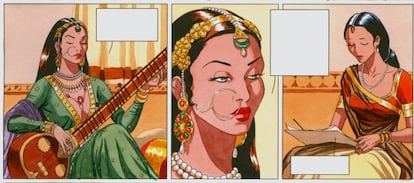The women comic book artists who are proving a big draw
“Now it is a livelihood, but back when I started it was simply unthinkable"

If there is any noticeable trend in the Valencian comic book scene, besides the success of Paco Roca (the creator of Arrugas, the award-winning story about Alzheimer's disease), it would be the rise of women cartoonists.
At first it was just Ana Miralles and Ana Juan. It was the 1980s, and they were working in a male-dominated world. Juan eventually concentrated on illustration work, but three decades later Miralles is still putting out new comic books.
"Back then, comic books did not make for an impressive calling card," she recalls. "People did not think that was a serious job. By persevering, by not giving up on our dreams, many of us have turned comic books into our livelihood and into a full-time job; but back when I started it was simply unthinkable."
Born in Madrid in 1959, Ana Miralles lived in Valencia from 1973 to 2006. These days she lives in Santander, where she moved because "there came a time when conditions became unlivable there because of the construction boom." Miralles jokes she considers herself "an environmental refugee."
She normally works for companies in Belgium and France, which in turn sell the rights to Spain and other countries. Her eighth album series, Djinn, took first prize at the 27th Barcelona International Comic Fair.
She always remembers reading comic books at home, just as her parents and sister did. "It was in the last year of my fine arts studies when I decided to devote my life to comic books. It was a slow but inexorable process," she says.
In the case of Cristina Durán, 41, the decision came long before that. "I studied fine arts precisely because of comic books," says the illustrator, who met her romantic and professional partner, Miguel Ángel Giner, through a fanzine, No Aparcar Llamo GRÚA.
Durán was the only female student in her class who drew comic books, but she won several prizes for amateur cartoonists. Then, working out of a studio in Benetússer called La Grúa Estudio, she found a niche in the international market with her first graphic novel, Una posibilidad entre mil, a finalist in the 2010 National Comic Book Prize.
"It was Miguel Ángel who convinced me to make a graphic novel that would tell the story of Laia; there was this need to take the story out," she says in reference to her own daughter, who suffers from cerebral palsy. "Besides, we had to make it a positive story in the end."
Besides these two well-placed cartoonists, there are new names pushing their way up such as Lydia Sánchez and Julia Cejas. Asked how you get to where she is right now, Durán says: "You have to fight for it, because it's not just about enjoying your own creative work, but also about being good professionals and being able to make a decent living out of it."







































